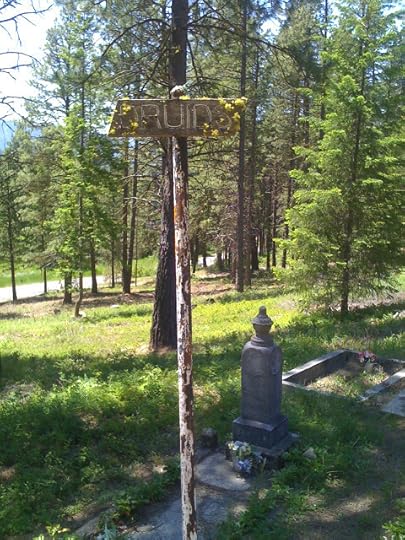Luna (Lindsey) Corbden's Blog, page 9
May 18, 2012
Druids in the Graveyard (photo)
Published on May 18, 2012 08:00
May 15, 2012
What's So Wrong with Being the Healer?
Today an interesting conversation came up in my Twitter feed. It echoed a conversation I had with one of my daughters yesterday, about the role of gender and the celebration of fighting over more peaceful activities. With my daughter, we discussed girl cartoons vs boy cartoons.
Specifically, Jem, who uses science and technology to create music, vs. the Transformers, who use science and technology to cause devastating explosions. Even though my daughter is female, she thought the girl-shows were lame. Shooting things was much, much better.
The Twitter conversation was about gaming, specifically related to today's release of Diablo III.
One could easily imagine a man mocking a female gamer by making the above statement in a highpiched voice. "And then my girlfriend was all like, 'Are there healer thingies? Can I follow you around and heal all the things? PLEASE?' and I was all line, no ho, get back in the kitchen!" (Cue bass laughter.)
I didn't see the original post first. I saw the reaction:
— Andrea Jen. Shubert (@andrea2s1) May 15, 2012This is an understandable response. i.e. stop acting the stereotype, because you're going to prove what men have been saying about us all along!
This kind of thinking makes a few assumptions that bother me. It assumes that being a healer is undesirable.
There are simulations of living things flying around on the screen and the healer is not helping them to die. You're just going around making injured people feel better, and that is not very respectable.
There is a kernel of fundamental sexism rooted in this assumption, so deeply, that most people, even women, miss it. It is such a basic part of our mental reality that we take it for granted. The male paradigm of what is important, and what is not, is so accepted as truth that we will not question it.
The question should be: What's so bad about healing?
We assume it's weak. We assume it is not very hard. We assume it requires no skill. We assume it doesn't help anyone win the game.
Yet none of this is true. In most serious MMORPGs, there are basically three roles (sometimes broken into sub-roles):
Tank: Takes damage and keeps mobs (monsters) from attacking other players.DPS: Deals massive damage. Can be ranged or melee.Healer. Heals people and buffs them (makes them stronger).Anyone who has seriously played an MMORPG actually knows, deep down inside, that healing is essential. It is a difficult skill to master. A poor healer will cause a party to wipe far more often than a poor damage class or tanking class. The tank's primary job, actually, is to keep the healer alive.
A good healer can often make up for poor performance on the part of any other class. Our team is not doing enough damage? That's okay. I will keep you alive long enough to kill it. It just means the fight takes longer, but we will live through it.
A healer in PvP (Player vs. Player, considered some of the most hardcore gaming on MMOs) is golden. A team with good healers will beat a team with no healers or bad healers any day.
I rarely play a healer. I rarely feel up to muster. I know that the tank (who usually leads parties) will chew my hide if I fail as a healer. Healers get yelled at. Healers hold the life of the party in their hands.
My lovely girlfriend? She is happy to take on this enormous responsibility, and I respect her for that. And she is good at it. And every time there are open calls for raid parties or in PvP queues, she is first in line. All healers are. Because there aren't enough of them to go around.
Maybe there aren't enough of them because the role is downplayed. Because it's sissy. That's a character only girls play. Or the larger picture: The role of healing in our entire society is downplayed. Who cares about healing when we can build stuff, or better yet, kill things?
So a lot of men don't want to play healers. And a lot of women trying very hard not to seem like women don't want to play healers. (I didn't want to give this video airplay by linking, but it is appropriate.) What we end up with is a shortage of healers. It should be obvious to everyone how necessary they are, when a party can't even do a raid without them.
Another gaming analogy went around today. John Scalzi wrote about how being a white male is like playing an MMO on easy, while everyone else has to play on hard. Games simulate life, and so it only makes sense to bring the metaphors back to reality. What can we learn about real life from looking at how healers are perceived?
Think about our healing classes in real life: Teachers, nurses, mothers, day care providers, HR managers, psychologists, massage therapists, social workers.
Unless you're lying to yourself, or an alien, your idea of these careers evokes a reaction in you: One Big Giant "Meh!" Who wants to do any of these things? Compared to rocket scientist or police officer or lawyer or airline pilot, no one does. They are weak roles, anyone can do them. They are boring, at best necessary evils - the kids must be taught, and someone has to clean up after sick people. Only janitors show up lower on the totem pole, in terms of respected careers.
(Doctors are an exception, a respected healing class. Perhaps that is because it is still not a female-dominated career. Many of the above listed careers more respected back when they were male-dominated.)
Is the problem that women act in nurturing ways? Take nurturing jobs? Are we too eager to be healers?
Or is the problem that we accept the sexist undervaluing of these roles?
Rearing children is amazingly cool. It is difficult. It requires skill, and it helps society win the game.
Psychology is awesome. It fixes people's brains. It makes people happy. It is difficult. It takes a lot of skill, and helps society win.
Social workers help lift people up, keep people going through hard times. It is difficult. It helps society win.
Admin assistants (aka secretaries) are awesome. Like healers in MMOs, they juggle a thousand different things, run all over the place, get it all done in time, and get yelled at if they let anyone fall down. It is difficult. They help a company win.
We could "stop acting the stereotype", but that won't lift the oppression. If we are reacting against the gender roles by stepping into male shoes, we validate the existence of those roles. We continue to perpetuate them and allow them to oppress us.
If women are avoiding acting the stereotype so we can be "free" of oppression, then we're no more free than we were barefoot and pregnant. Sure, it will lift oppression for women who would rather work in male-dominated fields (as I once did in IT, and arguably, still do as a writer). It will help women who want to be successful tanks and damage-dealers. And that's great.
But it won't help those people, both women and men , who want to be healers.
What we need to do is not question the stereotype, but question the value placed on the stereotype. What's so wrong with choosing to be a mother, if that choice is available to you? What is so wrong with being a nurse or an HR manager? What is wrong with being a healer?
Women should be able to play whatever character we want.
This goes past gender politics. This goes to the bedrock of some of the ills of society. This world is in need of good healers. Humanity needs more people (men and women) competently doing very difficult and valuable jobs. If we respected the results of good healing as much or more than we respect skillful damage-dealing, perhaps we'd have fewer lawsuits and wars, and more happy, healthy, functional people.
Gaming shows us it's possible to heal and be competitive. It is possible to heal and help everyone else win. It is possible to cooperate and win in a competitive way. Let's learn from that.
We've been programmed to dis peaceniks (hippies and sissies, the lot of them), just as we laugh at healers. In the long run, shifting our values could make for a better society, one in which it is valuable to heal and be healed.
If you are a healer, you are awesome.

Specifically, Jem, who uses science and technology to create music, vs. the Transformers, who use science and technology to cause devastating explosions. Even though my daughter is female, she thought the girl-shows were lame. Shooting things was much, much better.
The Twitter conversation was about gaming, specifically related to today's release of Diablo III.
I'm kind of excited about playing D3 with the Boyfriend. Are there healers? Can I follow him around and heal all the things?Oestrus is a woman. For those who might not automatically guess, this statement is potentially controversial in a gender-politics kind of way. Why? Because stereotypically, women are healers in games. Moreover, this reflects real life, in which women are healers, nurturers, and in general, sissies. (The word "sissy" was invented to describe what weak little girls women can be. Men can be unflatteringly accused of being in this state.)
— Oestrus (@OriginalOestrus) May 15, 2012
One could easily imagine a man mocking a female gamer by making the above statement in a highpiched voice. "And then my girlfriend was all like, 'Are there healer thingies? Can I follow you around and heal all the things? PLEASE?' and I was all line, no ho, get back in the kitchen!" (Cue bass laughter.)
I didn't see the original post first. I saw the reaction:
— Andrea Jen. Shubert (@andrea2s1) May 15, 2012This is an understandable response. i.e. stop acting the stereotype, because you're going to prove what men have been saying about us all along!
This kind of thinking makes a few assumptions that bother me. It assumes that being a healer is undesirable.
There are simulations of living things flying around on the screen and the healer is not helping them to die. You're just going around making injured people feel better, and that is not very respectable.
There is a kernel of fundamental sexism rooted in this assumption, so deeply, that most people, even women, miss it. It is such a basic part of our mental reality that we take it for granted. The male paradigm of what is important, and what is not, is so accepted as truth that we will not question it.
The question should be: What's so bad about healing?
We assume it's weak. We assume it is not very hard. We assume it requires no skill. We assume it doesn't help anyone win the game.
Yet none of this is true. In most serious MMORPGs, there are basically three roles (sometimes broken into sub-roles):
Tank: Takes damage and keeps mobs (monsters) from attacking other players.DPS: Deals massive damage. Can be ranged or melee.Healer. Heals people and buffs them (makes them stronger).Anyone who has seriously played an MMORPG actually knows, deep down inside, that healing is essential. It is a difficult skill to master. A poor healer will cause a party to wipe far more often than a poor damage class or tanking class. The tank's primary job, actually, is to keep the healer alive.
A good healer can often make up for poor performance on the part of any other class. Our team is not doing enough damage? That's okay. I will keep you alive long enough to kill it. It just means the fight takes longer, but we will live through it.
A healer in PvP (Player vs. Player, considered some of the most hardcore gaming on MMOs) is golden. A team with good healers will beat a team with no healers or bad healers any day.
I rarely play a healer. I rarely feel up to muster. I know that the tank (who usually leads parties) will chew my hide if I fail as a healer. Healers get yelled at. Healers hold the life of the party in their hands.
My lovely girlfriend? She is happy to take on this enormous responsibility, and I respect her for that. And she is good at it. And every time there are open calls for raid parties or in PvP queues, she is first in line. All healers are. Because there aren't enough of them to go around.
Maybe there aren't enough of them because the role is downplayed. Because it's sissy. That's a character only girls play. Or the larger picture: The role of healing in our entire society is downplayed. Who cares about healing when we can build stuff, or better yet, kill things?
So a lot of men don't want to play healers. And a lot of women trying very hard not to seem like women don't want to play healers. (I didn't want to give this video airplay by linking, but it is appropriate.) What we end up with is a shortage of healers. It should be obvious to everyone how necessary they are, when a party can't even do a raid without them.
Another gaming analogy went around today. John Scalzi wrote about how being a white male is like playing an MMO on easy, while everyone else has to play on hard. Games simulate life, and so it only makes sense to bring the metaphors back to reality. What can we learn about real life from looking at how healers are perceived?
Think about our healing classes in real life: Teachers, nurses, mothers, day care providers, HR managers, psychologists, massage therapists, social workers.
Unless you're lying to yourself, or an alien, your idea of these careers evokes a reaction in you: One Big Giant "Meh!" Who wants to do any of these things? Compared to rocket scientist or police officer or lawyer or airline pilot, no one does. They are weak roles, anyone can do them. They are boring, at best necessary evils - the kids must be taught, and someone has to clean up after sick people. Only janitors show up lower on the totem pole, in terms of respected careers.
(Doctors are an exception, a respected healing class. Perhaps that is because it is still not a female-dominated career. Many of the above listed careers more respected back when they were male-dominated.)
Is the problem that women act in nurturing ways? Take nurturing jobs? Are we too eager to be healers?
Or is the problem that we accept the sexist undervaluing of these roles?
Rearing children is amazingly cool. It is difficult. It requires skill, and it helps society win the game.
Psychology is awesome. It fixes people's brains. It makes people happy. It is difficult. It takes a lot of skill, and helps society win.
Social workers help lift people up, keep people going through hard times. It is difficult. It helps society win.
Admin assistants (aka secretaries) are awesome. Like healers in MMOs, they juggle a thousand different things, run all over the place, get it all done in time, and get yelled at if they let anyone fall down. It is difficult. They help a company win.
We could "stop acting the stereotype", but that won't lift the oppression. If we are reacting against the gender roles by stepping into male shoes, we validate the existence of those roles. We continue to perpetuate them and allow them to oppress us.
If women are avoiding acting the stereotype so we can be "free" of oppression, then we're no more free than we were barefoot and pregnant. Sure, it will lift oppression for women who would rather work in male-dominated fields (as I once did in IT, and arguably, still do as a writer). It will help women who want to be successful tanks and damage-dealers. And that's great.
But it won't help those people, both women and men , who want to be healers.
What we need to do is not question the stereotype, but question the value placed on the stereotype. What's so wrong with choosing to be a mother, if that choice is available to you? What is so wrong with being a nurse or an HR manager? What is wrong with being a healer?
Women should be able to play whatever character we want.
This goes past gender politics. This goes to the bedrock of some of the ills of society. This world is in need of good healers. Humanity needs more people (men and women) competently doing very difficult and valuable jobs. If we respected the results of good healing as much or more than we respect skillful damage-dealing, perhaps we'd have fewer lawsuits and wars, and more happy, healthy, functional people.
Gaming shows us it's possible to heal and be competitive. It is possible to heal and help everyone else win. It is possible to cooperate and win in a competitive way. Let's learn from that.
We've been programmed to dis peaceniks (hippies and sissies, the lot of them), just as we laugh at healers. In the long run, shifting our values could make for a better society, one in which it is valuable to heal and be healed.
If you are a healer, you are awesome.
Published on May 15, 2012 14:18
April 18, 2012
Roll It Up (Prototype)
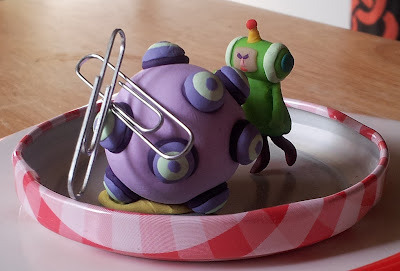 Roll Up The World
Roll Up The WorldIf you have no idea what you're looking at, go get some context first. Katamari Damacy is a surrealist Japanese video game series that broke all genres. That tiny little green guy is rolling around that sticky nodule-coated ball, and as he collects items, the ball grows bigger. You start off in a house picking up bugs and candy, and by the end of the game...
SO FUN.
Yesterday, I got a random idea. Make a paperclip holder out of Sculpey and rare earth magnets.
While discussing it on Twitter, someone pointed out that the Curie Point might thwart my plans, since polymer clay requires baking in the over to set, and heat can misalign the magic glue fairies inside the metal so they can't stick anymore.
Poly clay bakes at relatively low temperatures, and in theory should be low enough for neodymium to retain its animal magnetism, but someone linked someone else's project where oven-baking ruined perfectly good shiny metal miracles. So it was clear science needed to be committed.
The above prototype was a success. It is much tinier than the proposed clip-holder, but in true Katamari Damacy form, the Prince will role up some paperclips now, and grow in size, until in envelopes my pencils, my tea cup, Lorenz the Butterfly, Helga the Skull, the houseplant, Ryuk the Pomeranian, my desk, then finally the children, me, the house, and [SPOILER!] eventually the sun.
As you can clearly see, those paperclips are sticking to something. I swear it's not superglue. After heating, the magnet retained its usefulness. And the resulting product is adorable.
Now I've gone and told the end of the story, so now let's, not-quite-Memento-style, flashback in time to the beginning.
It's actually been a few years since I've done anything with polymer clay. It's a medium I'm well-familiar with. I first worked with it as a teen, as I had an infinite supply from my parent's craft store. Back then I made castles and fairies and dragons. Aside from the time I tried to make Gir, I've stayed away from replicating licensed memes, and instead stuck to original art, since I had some crazy idea maybe I could make money at it some day.
Freed from my delusions, I now realize the value of the medium for cheap knockoffs of other people's characters. fnord
For supplies, I have a ton of clay I bought in 2005 from my silly Lunafisk urban vinyl projects. Some of the tools I've had since I was 13, and those are still my favorites. There are lots of great websites for how to work with this stuff, so I won't go into detail. Let's just say my favored style has always been to try to do impossibly tiny things, and had I not gotten to do this tiny prototype version, it might have been almost boring.
I stole the magnets from my boy-child. I'd given them to him in the first place as a Christmas gift, so there.
Most of the clay is actually Premo, not Sculpey, but whatever. Apparently, it's An Artist's Dream Come True™, but other than that, it's just like Sculpey.
More pics:
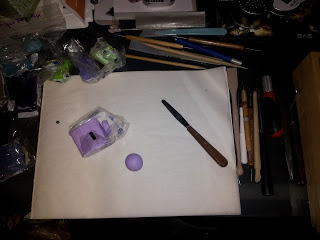 Tip: Use tracing paper for a surface - easy cleanup! Also clear acrylic sheets work well.
Tip: Use tracing paper for a surface - easy cleanup! Also clear acrylic sheets work well.
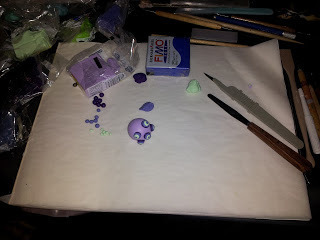 The Katamari grows bumps. Please ignore the Fimo. Fimo sucks.I was a bit worried about even placement of the nodules, until I noticed it's simple: One at the top, one at the bottom, then five evenly placed in a row encircling the top one, likewise five encircling the bottom (staggering the top ones), and boom. Not necessarily in that order.
The Katamari grows bumps. Please ignore the Fimo. Fimo sucks.I was a bit worried about even placement of the nodules, until I noticed it's simple: One at the top, one at the bottom, then five evenly placed in a row encircling the top one, likewise five encircling the bottom (staggering the top ones), and boom. Not necessarily in that order. Obviously when working with poly clay, you have to watch the smoosh factor and do things in order of least smooshy.
The bumps ended up mostly even (don't worry, that link is hilariously relevant; you'll see), but I messed up just a little bit, which is another good reason I'm practicing on a prototype.
There wasn't much room for the magnet, and I had smoosh-factor to worry about, so I placed it on top of the dark-purple circle, under the light-purple circle. Since it's a prototype, and I didn't know if the oven would obliterate the magnet's awesome, gravity-defying powers, I only wasted one magnet, on one nodule.
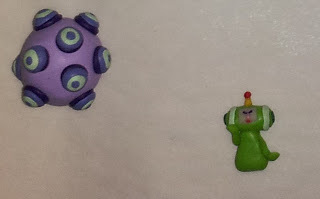 "Hello, I have no legs. teeheehee."But which one is it?
"Hello, I have no legs. teeheehee."But which one is it?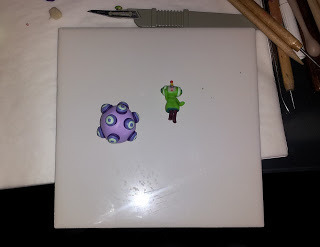 On the baking tile. "Please don't cut me with that scalpel!"Time for baking. The instructions have been the same since 1988 when I first squished my first baby dragon into existence. (Funny, he was exactly the same shade of green as our Prince here!)
On the baking tile. "Please don't cut me with that scalpel!"Time for baking. The instructions have been the same since 1988 when I first squished my first baby dragon into existence. (Funny, he was exactly the same shade of green as our Prince here!)15 minutes on 275°F. If we are to account for any magnetism loss, we should know the exact temperature and time so we can later make adjustments if nec--
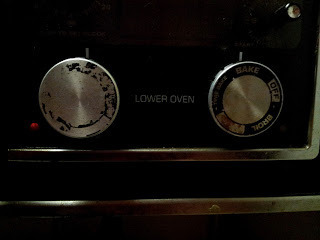 When doing science, always be sure to use precise instrumentation.So yeah... this is our oven. I set it to gggbbbbleeerrrghghhhhh and took careful records.
When doing science, always be sure to use precise instrumentation.So yeah... this is our oven. I set it to gggbbbbleeerrrghghhhhh and took careful records.Since I didn't know how hot it was, I set my timer for 8 minutes and waited, checking constantly by opening the door, causing heat to leave the oven rapidly, and when it didn't seem hot enough, I turned it up a little, and then decided to leave it in for less time, because, after all, it's a super-tiny piece, and small bakes faster than large projects.
Five minutes in, my daughter reminds me we have a brand new toaster oven. With a window.
Oh.
Next time.
When committing acts of science, try to reduce as many variables as possible. This is an example of all the things not to do.
Nevertheless, after approximately 15 minutes...
 Put the "tiny" back into Destiny!You are my density!
Put the "tiny" back into Destiny!You are my density!Did I say density? I mean DESTINY! Density comes later, when I create the full-size model, and we realize just how dense polymer clay really is.
Now we wait for it to cool, so that we don't end up playing with it too much and accidentally dropping it and breaking his arm off--
Woops.
No cameras please.
Ok, superglue later, The Prince's arm is back on, he's neatly glued to the Katamari in a brilliant case of ironyappositeness, and my fingers have +1 plasti-armor verses ants.
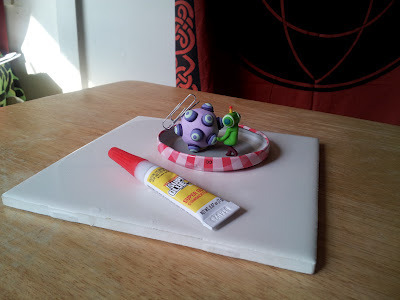 Do-doo-doot-doo doo doo doo doo doot!
Do-doo-doot-doo doo doo doo doo doot! Na NA nananana Na na na NA NA nana NAAAA!
Na NA nananana Na na na NA NA nana NAAAA!Superglue tip #1: Don't let the tube explode when you open it.
Superglue tip #2: If the tube explodes when you open it, under no circumstances should you try to rub it off of whatever it gets on. Especially yourself.
Superglue tip #3: This is because superglue was developed by the army to glue soldiers back together.
Superglue tip #4: If you have leveled up enough in the skill: Superglue, like I have, you lose all instincts to rub your fingers together, EVEN IF THERE'S GLUE RUINING YOUR KILT. I made my roll. whew!
Superglue tip #5: Superglue is the only kind of glue that doesn't melt poly clay.
Now back to regularly scheduled Katamari Prototype Pix:
 Paperclips of Unusual Size
Paperclips of Unusual Size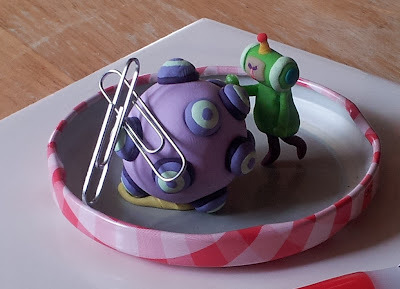 Now, if only there was an evil villain paperclip around here someplace I could roll up!
Now, if only there was an evil villain paperclip around here someplace I could roll up!
In the sequel, I will make the larger Katamari with a magnet in each nodule for holding ALL THE THINGS PAPERCLIP. Then we can safely store paperclips once and for all!
Published on April 18, 2012 18:28
April 16, 2012
New Cover for Make Willing the Prey
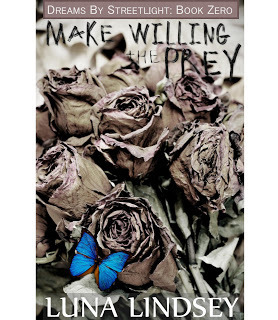
Make Willing the Prey had an old cover, and while it was good enough, I wanted something updated and in-line with my Dreams by Streetlight series. In other words, it needed to match Emerald City Dreamer. But since this is a prequel, and a bit more scary than Urban Fantasy is supposed to be, I also wanted it to say, "Horror". Hopefully I've pulled that off here.
I used stock photos that I paid a few bucks for over at pixmac.com. I used the Gimp for the background art, and Inkscape for the layout. Inkscape worked out much better in almost every way than my last tool, Scribus. Overall, the project took around six hours, and an extremely low level of skill.
I will be uploading it tonight, so the book should be refreshed tomorrow.
Here is the old cover, since I can't throw anything away:

Published on April 16, 2012 18:10
March 17, 2012
Emerald City Dreamer Launched!


Today am pleased to announce the release of my first full-length novel, Emerald City Dreamer, on Amazon Kindle. I am twice as pleased that the timing, by chance, brought it up right after midnight on St. Patrick's Day. I love synchronicities, and the past 24 hours has shown me several. Every new epoch of my life is peppered with synchronicistic events, and the fact that St. Patrick's Day is America's celebration of the Emerald Isle is a nice twist. While my novel contains no leprechauns, there are korrigans, lutins, and one Irish-Japanese elf.
Emerald City Dreamer will show you the world of the fae from the perspective of both faerie hunters and faeries alike, revealing the conflict between iron vs. rain, science vs. art, facts vs. imagination, and the potential of dreams vs. unforgiving facts of cold-hard reality.
The main character, Jina, is a rock star, who exudes dream-energy, or toradh, that the faeries crave. Little do they know she is also hell-bent on destroying them.
Emerald City Dreamer is Book One in a series, Dreams by Streetlight. My novella, Make Willing the Prey, is a prequel, Book Zero, which covers Sandy and Jina's traumatic backstory. It doesn't really matter which order you read them in, although the writing in ECD is better. I wrote ECD intending it to be read first, so if you're not sure, start there.
(Note, Make Willing the Prey leans a little closer to the horror genre than urban fantasy -- i.e. it is scary.)
Emerald City Dreamer is available on KDP Select aka Amazon Lending Library, which means if you have Amazon Prime, you can read it for free. I also have tentative plans for a print version in the near-future. Also, if you're new to the ebook "thing", you can download Kindle software to just about any device - including smart phones and PCs. My favorite Kindle platform is my Android phone.
It was over a year and a half when I first began my notes and outline on this project. What a long journey. This week I've worked every waking moment to get it out on time. Last night I shed tears of joy and sat stunned in disbelief as I finally clicked the "Done" button on Kindle Desktop Publishing.
For all the people who helped and supported me, I wrote a long list of acknowledgements in the back pages of the novel. I'd like to again thank my family, the Cloud City Wordslingers, my beta readers, and of course my readers. No gratitude is ever enough, although I guess there's such a thing as "annoyingly too much". :)
What will I do to celebrate this accomplishment? I will force myself to stop working, just for today, and take a much-needed sanity break. I plan to play RoboTek HD on my newly inherited iPad (I told you there were synchronicities) for the rest of the day.
Please enjoy reading my book. If you like it, please tell your friends. And feel free to review me on Amazon, Good Reads, your blog, and anywhere else.
Published on March 17, 2012 14:14
March 16, 2012
Final Cover... (or IS it?)
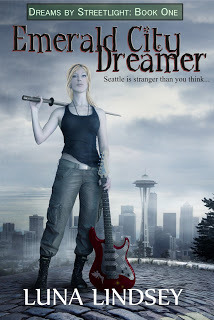
This is what I went with. I had a number of people offer feedback, and my friend Michael Montoure even did his own fantastic design, which I borrowed some ideas from. I took all of your advice, except one good suggestion from two people, relating to the title, which would have been too time-consuming to implement with the tools I used.
Everything is uploaded to Amazon and pending publication. Look forward to an announcement tomorrow. It's a perfect synchronicity -- tomorrow is St. Patrick's Day, and my book is about faeries! How's that for lucky charms?
Published on March 16, 2012 18:01
March 15, 2012
Cover Draft - Judge This Cover
Here it is, at long last:
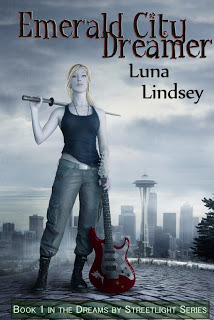
This is a low-res JPEG draft of my cover with layout. I am not an expert at design, although I know a couple of the basics. Please let me know what you think, and if there's something I could do better, please let me know!
This was designed with the Amazon site in mind. I made sure the title and my name are both readable at super-tiny thumbnail sizes. I also wanted it to look good at Amazon's medium thumbnail size, and work as a trade-paper cover in a large size. (It may need slight tweaks for the trade paper version. My focus was on the initial ebook release.)
Please leave feedback in the comments. Thanks!

This is a low-res JPEG draft of my cover with layout. I am not an expert at design, although I know a couple of the basics. Please let me know what you think, and if there's something I could do better, please let me know!
This was designed with the Amazon site in mind. I made sure the title and my name are both readable at super-tiny thumbnail sizes. I also wanted it to look good at Amazon's medium thumbnail size, and work as a trade-paper cover in a large size. (It may need slight tweaks for the trade paper version. My focus was on the initial ebook release.)
Please leave feedback in the comments. Thanks!
Published on March 15, 2012 14:16
Cover Draft - Request for Feedback
Here it is, at long last:

This is a low-res JPEG draft of my cover with layout. I am not an expert at design, although I know a couple of the basics. Please let me know what you think, and if there's something I could do better, please let me know!
This was designed with the Amazon site in mind. I made sure the title and my name are both readable at super-tiny thumbnail sizes. I also wanted it to look good at Amazon's medium thumbnail size, and work as a trade-paper cover in a large size. (It may need slight tweaks for the trade paper version. My focus was on the initial ebook release.)
Please leave feedback in the comments. Thanks!

This is a low-res JPEG draft of my cover with layout. I am not an expert at design, although I know a couple of the basics. Please let me know what you think, and if there's something I could do better, please let me know!
This was designed with the Amazon site in mind. I made sure the title and my name are both readable at super-tiny thumbnail sizes. I also wanted it to look good at Amazon's medium thumbnail size, and work as a trade-paper cover in a large size. (It may need slight tweaks for the trade paper version. My focus was on the initial ebook release.)
Please leave feedback in the comments. Thanks!
Published on March 15, 2012 14:16
March 8, 2012
Emerald City Dreamer Cover Art
One of the best parts about going indie is having full control over the cover art. My artist is Ana Cruz, (DeviantArt profile) and I was able to explain to her my vision, and work with her until the cover art for Emerald City Dreamer was perfect. She was a joy to work with. I am very proud of the final product:
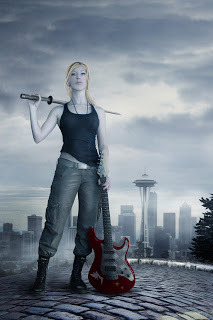
I will be doing design myself, which includes cropping and adding the title.
Some people may wonder how this process works. I will tell you.
I went to DeviantArt.com and searched on "fairy", not only to find an artist, but to get an idea of what kind of cover I wanted. I had recently browsed the sci-fi/fantasy section at the bookstore to see what current trends were, so I didn't end up with something out of date.
By browsing here, I decided I wanted a photo manipulation style, and then I let my visualization processes stew for a while until I imagined my character in the pose I wanted, with props and background. I made a terrible sketch in pencil just so I could remember the details, bookmarked the artists and images I liked, and waited a few months. (I was still running the manuscript past my fellow Wordslingers, and publication was still far off.)
When I returned to the process, I ruled out the artists I had bookmarked for various reasons, so I had to start over again -- this time I searched for "photo manipulation". I chose three artists based on these criteria: 1) I liked their art, 2) they seemed professional -- i.e. they presented their gallery in a professional manner, they listed the fact that they took commissions, they had their own website, and they had a portfolio of previously commissioned work.
Here are some examples of what I looked for. Notice the sidebars are well laid out, contain links to offsite profiles including a professional website, and they state she offers artistic services. Deviant Art hobbyists often do amazing work, but will not list their credentials or mention commissions. They may or may not be able to do a great cover for you, and who knows if they can act professionally.
I contacted these artists with a professional, serious email, stating my intentions and asking for details such as timeline and price. I settled on one artist, but her workload was full, so I started the process again, contacting three more artists, at which point I found Ana.
What impressed me most about Ana was her professional attitude in her email replies. She stated that she always produces a "sketch" or outline of the art before spending too many hours on it, so that if there were foundational corrections, it saves time and money. That showed me that she'd given this lots of thought. If you are commissioning cover art, I would strongly recommend you request this of the artist. Given that this is a digital image, my "sketch" was full color and consisted of the basic model standing in front of the basic background. Details such as her hair, props, touch-ups, color-finishing, etc. had not yet been done. The feedback I gave at this level greatly improved the direction of the image, so I was able to get exactly what I had envisioned.
As an indie writer, my toolbox needs to include the ability to describe an image to an artist in sufficient detail to get what I want. I'd had some practice on a tattoo I got just a few months before starting this, and I quickly learned not to be fuzzy on any detail. It forced me to really dive in and not gloss over anything I thought might be important. Ana was a perfect fit, because she was able to listen. She got it all, including the facial expression I wanted -- which I thought would be impossible to achieve.
The next time I do this, I will plan ahead a lot further. It's difficult when you're in the middle of the second draft of a novel to think about the cover art, and to commit to getting started on that piece, especially when you're full of uncertainties and self-doubt. But the process did take three or four months. Fortunately, I was far enough behind on the revisions, line edits, and everything else, that it didn't matter. Of course in the future, now that I've gone through the full process, I should be able to better plan the timing of everything.
They say you should also begin marketing efforts long before release date, and I don't even have a release date. I've been reluctant to commit to anything until certain things are done -- and it feels weird to market without a cover. For my second novel, I will be better prepared on all levels. This novel has very much been a learning process.

I will be doing design myself, which includes cropping and adding the title.
Some people may wonder how this process works. I will tell you.
I went to DeviantArt.com and searched on "fairy", not only to find an artist, but to get an idea of what kind of cover I wanted. I had recently browsed the sci-fi/fantasy section at the bookstore to see what current trends were, so I didn't end up with something out of date.
By browsing here, I decided I wanted a photo manipulation style, and then I let my visualization processes stew for a while until I imagined my character in the pose I wanted, with props and background. I made a terrible sketch in pencil just so I could remember the details, bookmarked the artists and images I liked, and waited a few months. (I was still running the manuscript past my fellow Wordslingers, and publication was still far off.)
When I returned to the process, I ruled out the artists I had bookmarked for various reasons, so I had to start over again -- this time I searched for "photo manipulation". I chose three artists based on these criteria: 1) I liked their art, 2) they seemed professional -- i.e. they presented their gallery in a professional manner, they listed the fact that they took commissions, they had their own website, and they had a portfolio of previously commissioned work.
Here are some examples of what I looked for. Notice the sidebars are well laid out, contain links to offsite profiles including a professional website, and they state she offers artistic services. Deviant Art hobbyists often do amazing work, but will not list their credentials or mention commissions. They may or may not be able to do a great cover for you, and who knows if they can act professionally.
I contacted these artists with a professional, serious email, stating my intentions and asking for details such as timeline and price. I settled on one artist, but her workload was full, so I started the process again, contacting three more artists, at which point I found Ana.
What impressed me most about Ana was her professional attitude in her email replies. She stated that she always produces a "sketch" or outline of the art before spending too many hours on it, so that if there were foundational corrections, it saves time and money. That showed me that she'd given this lots of thought. If you are commissioning cover art, I would strongly recommend you request this of the artist. Given that this is a digital image, my "sketch" was full color and consisted of the basic model standing in front of the basic background. Details such as her hair, props, touch-ups, color-finishing, etc. had not yet been done. The feedback I gave at this level greatly improved the direction of the image, so I was able to get exactly what I had envisioned.
As an indie writer, my toolbox needs to include the ability to describe an image to an artist in sufficient detail to get what I want. I'd had some practice on a tattoo I got just a few months before starting this, and I quickly learned not to be fuzzy on any detail. It forced me to really dive in and not gloss over anything I thought might be important. Ana was a perfect fit, because she was able to listen. She got it all, including the facial expression I wanted -- which I thought would be impossible to achieve.
The next time I do this, I will plan ahead a lot further. It's difficult when you're in the middle of the second draft of a novel to think about the cover art, and to commit to getting started on that piece, especially when you're full of uncertainties and self-doubt. But the process did take three or four months. Fortunately, I was far enough behind on the revisions, line edits, and everything else, that it didn't matter. Of course in the future, now that I've gone through the full process, I should be able to better plan the timing of everything.
They say you should also begin marketing efforts long before release date, and I don't even have a release date. I've been reluctant to commit to anything until certain things are done -- and it feels weird to market without a cover. For my second novel, I will be better prepared on all levels. This novel has very much been a learning process.
Published on March 08, 2012 12:24
December 25, 2011
The Most Peaceful Christmas Songs of All Time
In my previous post, I explained my theme this year for Christmas, which is peace. Here is a list of the Christmas songs which sing of peace, be they Christian of origin, or written by those silly fluffy hippies we're all supposed to hate.
Starting with the hippiest hippy of them all, John Lennon, in Happy Xmas.
Bing Crosby & David Bowie sing Little Drummer Boy with additional lyrics:
A spoof of the last video by Will Ferrel, which is for the most part a word-for-word remake. Until the end, where we see a little irony. (Not embedded, click link.)
And because the Internet is just one big spoof of itself, here is Jack Black:
Handel used the Bible as the primary source of lyrics for the Messiah. The message of this song is clear. It tells the story of the angels who came down to the Shepard. When they were afraid, the angel calmed them, promising them peace on earth, good will to men. This is the refrain I've had going through my head this season, any time I notice my cognitive dissonance surrounding the concept of peace.
I Heard the Bells on Christmas Day was one of my favorites to sing when I was a "sissy little girl". There are a number of different melodies, so I've included several versions. This song is all about peace, and how impossible the goal seems. In despair I bowed my head, 'There is no peace on earth,' I said. 'For hate is strong and mocks the song of peace on earth good will to men.' It offers hope that right will prevail.
This first version is the one I grew up singing:
A rocked out version of the same melody. I include it because its imagary ties it to modern events:
And a spiffy new version I'd not heard before:
Hark, here are those angels again. Peace on earth and mercy mild.
I just discovered this song, this year. Tim Minchin expresses some of my own conflicting feelings about this season, including the commercialism and mixed feelings about the Christian message. What's important, to him and me, is the love of being with family. White Wine in the Sun is one of my favorites on this list.
O Holy Night has a very peaceful melody. I almost did not include it because the first to verses speak of submission to God and hints at Christian superiority. But the third verse encapsulates the message I espouse:
Truly He taught us to love one another;
His law is love and His Gospel is peace.
Chains shall He break for the slave is our brother
And in His Name all oppression shall cease.
In case you're in doubt that I wish to emphasize the peaceful elements of this song, I've included the John Denver version:
Still, Still, Still:
While I was still Mormon, I loved Jars of Clay. Here's a Christmas song of theirs I still have in my playlist.
An Atheist Christmas Carol by Vienna Teng:
It Came Upon a Midnight Clear brings us more peace on earth:
Merry Christmas!
Published on December 25, 2011 15:06

